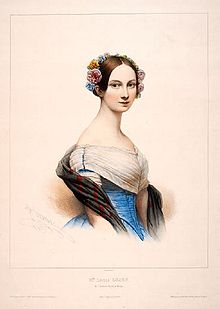Lucile Grahn
Lucile Grahn , with full birth name Lucina Alexia Grahn (born June 30, 1819 in Copenhagen , † April 4, 1907 in Munich ) was a Danish dancer and ballet master . She was considered the most talented Danish ballerina of the 19th century.
Life
Grahn made her debut as a child at the Royal Danish Ballet in 1829 , when choreographer August Bournonville took over her training, became her mentor and later fell in love with her. 1834 she followed at the age of only 15 years to 14 years older Bournonville to Paris at the Opera . Her dream of dancing there caused problems between her and Bournonville, who tried to prevent her from doing so. Grahn bypassed him, however, and turned directly to the Danish Princess Wilhelmina , who gave her permission for a guest performance.
After dancing for four months at the Paris Opera, she had the opportunity to represent the indisposed Fanny Elssler in La Sylphide, choreographed by Bournonville . The professional audience was of the opinion that Grahn's type was a better fit for this role than Fanny Elssler, who appeared to be more “down to earth”, and celebrated her accordingly, which made her older colleague jealous. This role is considered the greatest success of her career.
When she returned to Denmark, Bournonville continued to make life difficult for her. He was dictatorial, cruel and possessive - so she complained. But even against his wishes, she managed to get another royal approval for guest performances, this time six appearances in Hamburg. In 1839 she left Denmark and Bournonville and never returned. Her next important engagement was in Russia in 1840, where she took on Marie Taglioni's roles. Her guest appearance in Saint Petersburg was short-lived, as she met Elena Andreianova , who was also jealous and intriguing .
Grahn spent 1844 in Milan and then went to London. In the following two years she made only a few appearances. In 1845 she was invited by Jules Perrot to dance at Her Majesty's Theater in London in his Divertissement Pas de Quatre with Marie Taglioni, Carlotta Grisi and Fanny Cerrito , which was judged to be a special event among ballet fans because of the direct encounter between the feuding ballerinas. The four rival ballerinas could only be moved with difficulty to perform on July 12, 1845. According to an anecdote, each of the four ballerinas wanted to get on stage first. The dispute could not be resolved until the director suggested that the elder be given precedence.
In 1848 Grahn moved to Hamburg and became enthusiastic about life in Germany, so that she bought a house in Munich, where she lived from then on and taught and choreographed at what was then the Munich court theater . In 1856 she married the tenor Friedrich Young , born in Budapest in 1824 , who suffered such severe head injuries in an accident on the stage in Würzburg in 1863 that he had to end his career and died of the long-term effects in the Kennenburg Sanatorium in 1884 .
After 30 years of separation, Grahn met Bournonville again in 1869 and was reconciled with him, even if there was no longer a love affair. She outlived her husband by 23 years but no longer bonded. In her will, she bequeathed all of her property to the needy children of the city of Munich, who named a street next to the Prinzregententheater in her honor .
Grahn has been handed down as a lean, translucent, almost “ethereal” appearance, which, however, had a strong will and assertiveness.
literature
- Rolf Badenhausen : Grahn-Young, Lucile Alexia, née Grahn. In: New German Biography (NDB). Volume 6, Duncker & Humblot, Berlin 1964, ISBN 3-428-00187-7 , p. 734 f. ( Digitized version ).
- Ernst Probst: queens of dance . 2002. ISBN 3-935718-99-3
- Constantin von Wurzbach : Young, Lucile . In: Biographisches Lexikon des Kaiserthums Oesterreich . 59th part. Imperial-Royal Court and State Printing Office, Vienna 1890, p. 59 f. ( Digitized version ).
- Lucina Alexia Grahn , in: Encyclopedia Britannica
- Lucile Grahn . In: Carl Frederik Bricka (Ed.): Dansk biografisk Lexikon. Tillige omfattende Norge for Tidsrummet 1537-1814. 1st edition. tape 6 : Gerson-H. Hansen . Gyldendalske Boghandels Forlag, Copenhagen 1892, p. 161 (Danish, runeberg.org ).
Web links
- Works by and about Lucile Grahn in the German Digital Library
- Page about Lucile Grahn at the German Dance Archive Cologne .
Individual evidence
- ↑ German Theater Lexicon . Volume 7: Wolbring-Zysset. Berlin / Boston 2012, p. 3665
| personal data | |
|---|---|
| SURNAME | Grahn, Lucile |
| ALTERNATIVE NAMES | Grahn, Lucina Alexia (maiden name) |
| BRIEF DESCRIPTION | Danish dancer and ballerina |
| DATE OF BIRTH | June 30, 1819 |
| PLACE OF BIRTH | Copenhagen |
| DATE OF DEATH | April 4, 1907 |
| Place of death | Munich |

